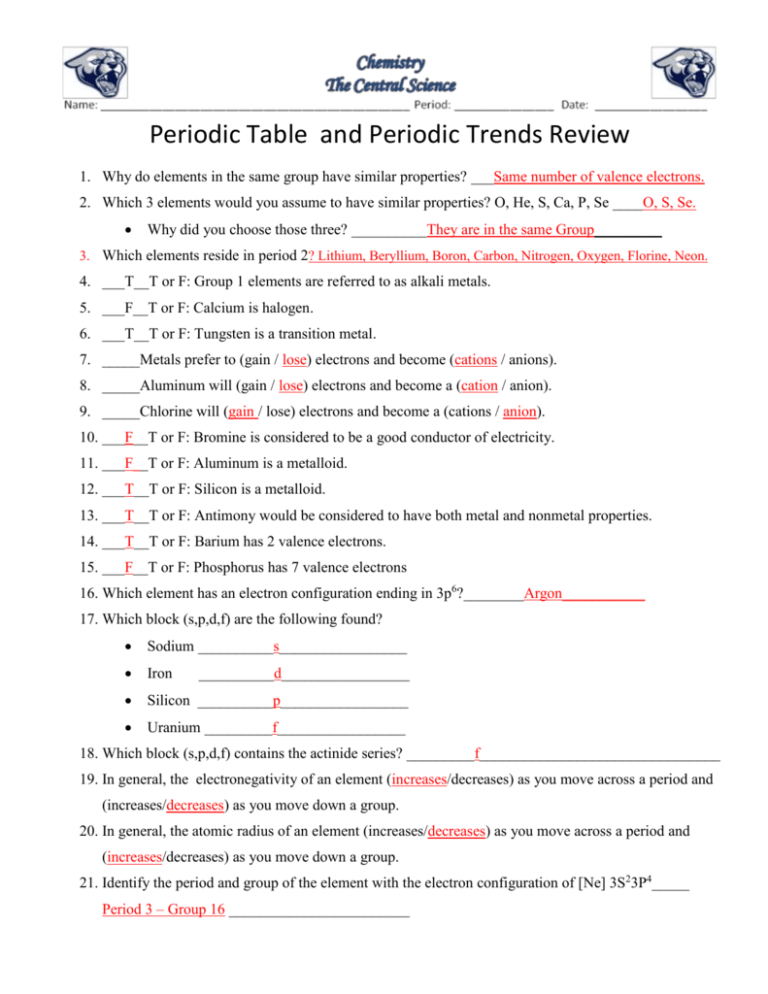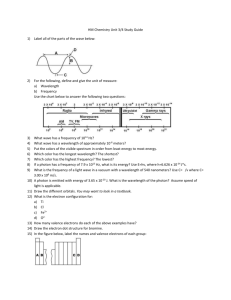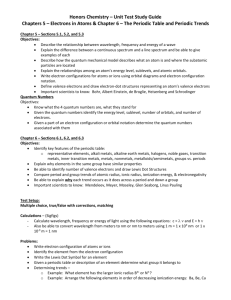Periodic Table and Periodic Trends Review Why do elements in the
advertisement

Periodic Table and Periodic Trends Review 1. Why do elements in the same group have similar properties? ___Same number of valence electrons. 2. Which 3 elements would you assume to have similar properties? O, He, S, Ca, P, Se ____O, S, Se. Why did you choose those three? __________They are in the same Group_________ 3. Which elements reside in period 2? Lithium, Beryllium, Boron, Carbon, Nitrogen, Oxygen, Florine, Neon. 4. ___T__T or F: Group 1 elements are referred to as alkali metals. 5. ___F__T or F: Calcium is halogen. 6. ___T__T or F: Tungsten is a transition metal. 7. _____Metals prefer to (gain / lose) electrons and become (cations / anions). 8. _____Aluminum will (gain / lose) electrons and become a (cation / anion). 9. _____Chlorine will (gain / lose) electrons and become a (cations / anion). 10. ___F__T or F: Bromine is considered to be a good conductor of electricity. 11. ___F__T or F: Aluminum is a metalloid. 12. ___T__T or F: Silicon is a metalloid. 13. ___T__T or F: Antimony would be considered to have both metal and nonmetal properties. 14. ___T__T or F: Barium has 2 valence electrons. 15. ___F__T or F: Phosphorus has 7 valence electrons 16. Which element has an electron configuration ending in 3p6?________Argon___________ 17. Which block (s,p,d,f) are the following found? Sodium __________s_________________ Iron Silicon __________p_________________ Uranium _________f_________________ __________d_________________ 18. Which block (s,p,d,f) contains the actinide series? _________f________________________________ 19. In general, the electronegativity of an element (increases/decreases) as you move across a period and (increases/decreases) as you move down a group. 20. In general, the atomic radius of an element (increases/decreases) as you move across a period and (increases/decreases) as you move down a group. 21. Identify the period and group of the element with the electron configuration of [Ne] 3S23P4_____ Period 3 – Group 16 ________________________ 22. What is the most important characteristic in determining an element’s chemical properties? __________The number of valence electrons. _______________________________ 23. Which element is most electronegative? C, Si, Ge, Sn ______C______________________________ 24. Which element has the largest radius? C, N, O, F __________C______________________________ 25. Which element has the highest ionization energy? C, N, O, F ____F___________________________ 26. Which element is most electronegative? C, N, O, F ___________F____________________________ 27. Which element is most electronegative? He, Cl, Al, P _________Cl____________________________ 28. Which element has the largest radius? C, Si, Ge, Sn ___________Sn _________________________ 29. Which element has the highest ionization energy? Ne, O, N, B ____Ne ________________________ 30. Elements in group III will want to (gain/lose) this amount of electrons: _____3___________________ 31. Elements in group VI will want to (gain/lose) this amount of electrons: ____2____________________ 32. Which group on the periodic table contains the least reactive elements? ____Noble Gasses_________ 33. Define: Electronegativity: A measurement of the intensity with which a atom or ion attracts an electron. Ionization energy: The amount of energy required to remove an electron from an atom._____ Atomic radius: 1/2 of the distance between the nuclei of two bonded atoms of the same element. Electrons: Small, negatively charged sub-atomic particles that have very little mass. Cation: A positively charged ion_________ Anion: A negatively charged ion.__________ 34. The periodic table is organized according to an elements ___Atomic Number__________ and was done so by whom? ____Henry Mosley____________________________ 35. Elements that are poor conductors of electricity are referred to as (metals, non metals, transition metals, metalloids) Metalloids_______________________________________ 36. Which element in the second period of the period table has the largest radius? ____Lithum_________ 37. Periods tell you the number of Energy Levels______ and element has, while groups designate the number of valence electrons__________. 38. Explain why positive ions are smaller in radius than the atoms from which they are formed, but negative ions are larger than the atoms from which they are formed. As atoms form positive ions, electrons are lost reducing the radius and when atoms gain electrons, the additional negative charges increase the radius of the ion_____________ 39. Which is larger? Mg or Mg2+ Explain:_____MG – Mg has three energy levels and Mg2+ only has 2. Cl or ClExplain:____Cl- because as the electron occupies the remaining orbital, the negative field repells other electrons thus increasing the ionic radius. ________________________________________________________






